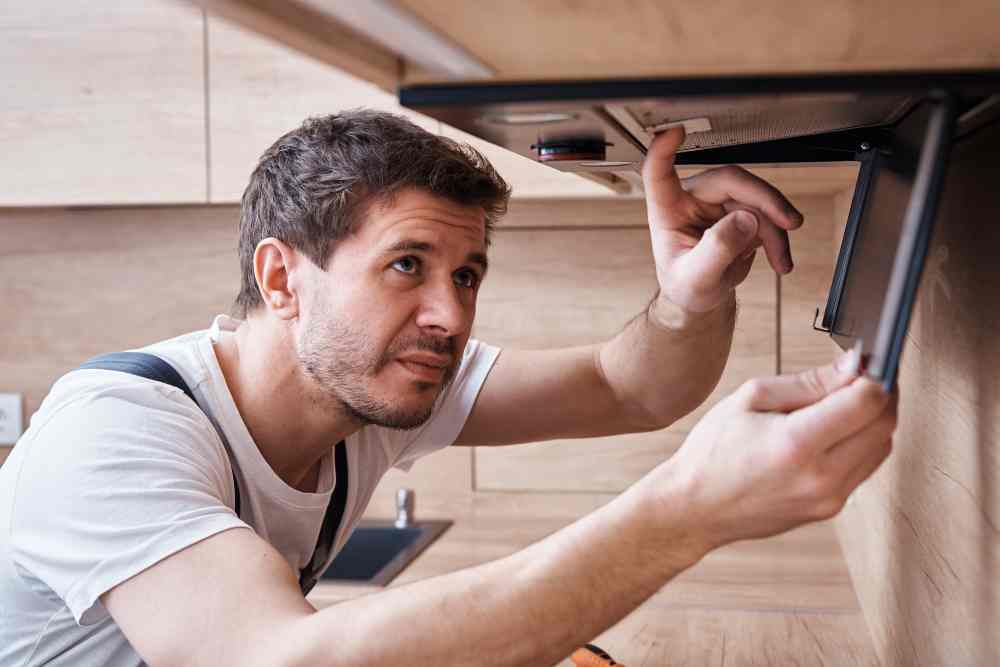Cleaning Kitchen Exhaust Without a Professional

Keeping your kitchen exhaust clean is essential for maintaining a healthy and safe environment in your home. A dirty kitchen exhaust can lead to a buildup of grease and other contaminants, which can not only affect the air quality in your kitchen but also pose a fire hazard. While it is recommended to hire a professional for a thorough cleaning, there are steps you can take to clean your kitchen exhaust on your own. In this article, we will explore the process of cleaning a kitchen exhaust without a professional, providing you with valuable insights and tips to ensure a clean and safe kitchen.
Ontario-wide Kitchen Exhaust and Hood Cleaning – Best prices and service guaranteed.
The Importance of Cleaning Your Kitchen Exhaust
Before diving into the cleaning process, it is crucial to understand why cleaning your kitchen exhaust is so important. Here are a few key reasons:
- Fire Safety: A dirty kitchen exhaust filled with grease can easily catch fire, posing a significant risk to your home and family. Regular cleaning helps prevent the buildup of flammable materials.
- Air Quality: A dirty kitchen exhaust can release harmful pollutants into the air, affecting the overall air quality in your home. This can lead to respiratory issues and other health problems.
- Efficiency: A clean kitchen exhaust operates more efficiently, allowing it to remove smoke, odors, and heat more effectively. This can help reduce energy consumption and improve the overall performance of your kitchen ventilation system.
Ontario-wide Kitchen Exhaust and Hood Cleaning – Best prices and service guaranteed.
Gather the Necessary Tools and Equipment
Before starting the cleaning process, it is essential to gather the necessary tools and equipment. Here are some items you will need:
- Protective gloves
- Eye protection
- Degreaser or kitchen exhaust cleaner
- Scrub brush or sponge
- Bucket
- Hot water
- Microfiber cloths
- Plastic bags
Turn Off the Power and Remove Filters
Ontario-wide Kitchen Exhaust and Hood Cleaning – Best prices and service guaranteed.
Before you begin cleaning, make sure to turn off the power to your kitchen exhaust system. This will prevent any accidents or injuries while you are working. Once the power is off, remove the filters from the exhaust hood. These filters are usually located underneath the hood and can be easily removed by following the manufacturer’s instructions.
Soak and Clean the Filters
Once the filters are removed, fill a bucket with hot water and add a degreaser or kitchen exhaust cleaner. Place the filters in the bucket and let them soak for at least 15 minutes. This will help loosen the grease and other contaminants stuck to the filters.
After soaking, use a scrub brush or sponge to clean the filters thoroughly. Scrub both sides of the filters to remove any remaining grease or dirt. Rinse the filters with hot water to remove any residue, and then let them air dry completely before reinstalling them.
Clean the Exhaust Hood and Ducts
Ontario-wide Kitchen Exhaust and Hood Cleaning – Best prices and service guaranteed.
While the filters are drying, it’s time to clean the exhaust hood and ducts. Start by using a degreaser or kitchen exhaust cleaner to spray the interior and exterior of the hood. Let the cleaner sit for a few minutes to break down the grease and grime.
Next, use a scrub brush or sponge to scrub the hood thoroughly. Pay close attention to areas with heavy grease buildup, such as the fan blades and corners of the hood. Rinse the hood with hot water to remove any residue, and then dry it with a microfiber cloth.
After cleaning the hood, it’s important to clean the ducts as well. This can be done by using a long-handled brush or a vacuum cleaner with a brush attachment. Insert the brush or attachment into the ducts and scrub or vacuum the interior to remove any accumulated debris or grease.
Reinstall the Filters and Test the System
Once the hood and ducts are clean and dry, it’s time to reinstall the filters. Make sure the filters are properly aligned and securely in place before turning the power back on. Once the filters are in place, turn on the kitchen exhaust system and test its performance. Ensure that the airflow is strong and that there are no unusual noises or vibrations.
Ontario-wide Kitchen Exhaust and Hood Cleaning – Best prices and service guaranteed.
Maintaining a Clean Kitchen Exhaust
Regular cleaning is essential for maintaining a clean and safe kitchen exhaust. Here are a few tips to help you maintain a clean kitchen exhaust system:
- Clean the filters at least once a month or as recommended by the manufacturer.
- Wipe down the exterior of the hood regularly to prevent grease buildup.
- Inspect the ducts for any signs of damage or blockage and address them promptly.
- Consider installing a grease trap or grease containment system to prevent grease from entering the exhaust system.
Ontario-wide Kitchen Exhaust and Hood Cleaning – Best prices and service guaranteed.
Cleaning your kitchen exhaust without a professional is possible with the right tools and knowledge. Regular cleaning not only improves fire safety but also enhances air quality and the overall efficiency of your kitchen ventilation system. By following the steps outlined in this article, you can ensure a clean and safe kitchen environment for you and your family.
Learn more about “How to DIY Clean Kitchen Exhaust” here.
Frequently Asked Questions about Cleaning Kitchen Exhaust Without a Professional

Can I Clean My Kitchen Exhaust System Without a Professional?
Yes, it’s possible to clean the more accessible parts of your kitchen exhaust system without hiring a professional. However, keep in mind that DIY cleaning won’t be as comprehensive as professional cleaning. Most DIY methods focus on the hood and filters, which are essential but are just a part of the entire exhaust system. Ductwork and fans often require specialized tools and techniques for a thorough cleaning. Still, regular light maintenance by homeowners can help maintain a cleaner system between professional cleanings.
What Are the Steps for Cleaning the Exhaust Hood and Filters?
The cleaning process starts by first turning off the exhaust fan and, if possible, disconnecting the electrical supply to the hood for safety reasons.
Remove Filters: Use a screwdriver to undo the screws holding the filters in place, then carefully remove them.
Soak Filters: Fill a sink or bucket with warm water and a grease-cutting dish soap. Let the filters soak for at least 30 minutes.
Scrub the Hood: Use a degreaser or a mixture of warm water and dish soap to scrub the inside of the hood. Avoid electrical connections and components.
Scrub Filters: After soaking, take a non-abrasive scrub brush to scrub off any remaining grease from the filters.
Rinse and Dry: Rinse the filters thoroughly with hot water and let them dry completely before reassembling them into the hood.
What Household Items Can Be Used to Clean the Kitchen Exhaust?
If you’re keen on using household items for cleaning, consider these alternatives:
Baking Soda: Mix it in water to create a paste. It acts as a mild abrasive suitable for scrubbing surfaces.
White Vinegar: A natural degreaser that can help loosen grime and grease.
Lemon: The citric acid in lemon is also effective against grease and can be used to wipe down surfaces.
You can make a cleaning solution using a mixture of these ingredients. However, for thick and stubborn grease layers, a commercial degreaser is generally more effective.
Is There a Maintenance Schedule for DIY Cleaning of Kitchen Exhaust?
While professional cleaning of the entire system is recommended at least once a year for residential kitchens, you can perform DIY cleaning of the hood and filters every one to three months, depending on how frequently you cook. This will keep the exhaust system functioning more efficiently and can prolong the intervals between professional cleanings.
What Safety Precautions Should Be Taken During DIY Cleaning?
Safety should be your primary concern while undertaking any cleaning or maintenance activity. Here are some essential safety measures:
Electrical Safety: Always disconnect the electrical supply before beginning any cleaning work.
Chemical Safety: Always use gloves when handling cleaning agents, especially degreasers or other strong chemicals.
Protect Your Eyes: Use safety goggles to protect your eyes from splashes of cleaning agents or dislodged grease.
Proper Ventilation: Ensure good airflow in the kitchen to disperse fumes from cleaning agents.
Remember, while DIY cleaning can help maintain your kitchen exhaust system, it does not replace the need for periodic, professional cleaning, which ensures the system is safe and up to code.
- Cleaning Kitchen Exhaust Without a Professional
- hood cleaning
- kitchen exhaust cleaning
- restaurant hood cleaning






